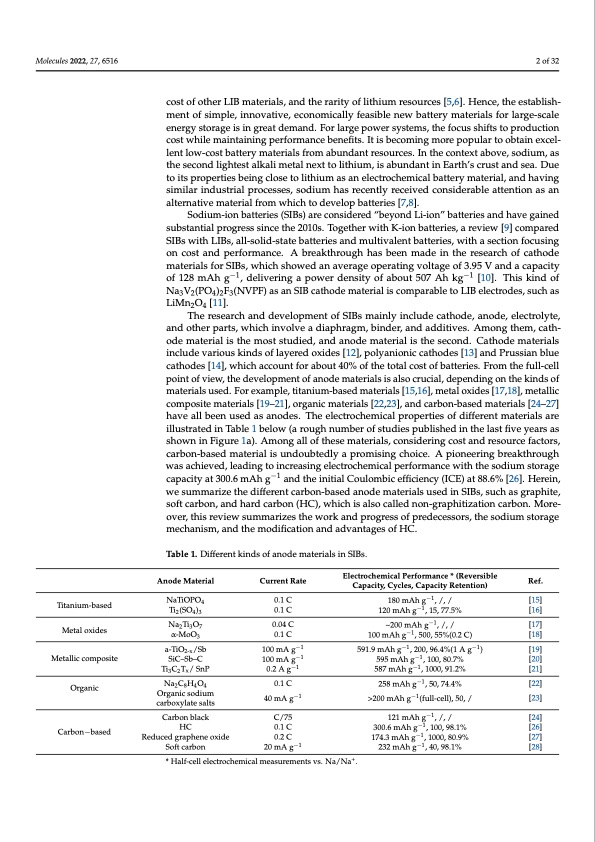
PDF Publication Title:
Text from PDF Page: 002
Molecules 2022, 27, 6516 2 of 32 cost of other LIB materials, and the rarity of lithium resources [5,6]. Hence, the establish- ment of simple, innovative, economically feasible new battery materials for large-scale energy storage is in great demand. For large power systems, the focus shifts to production cost while maintaining performance benefits. It is becoming more popular to obtain excel- lent low-cost battery materials from abundant resources. In the context above, sodium, as the second lightest alkali metal next to lithium, is abundant in Earth’s crust and sea. Due to its properties being close to lithium as an electrochemical battery material, and having similar industrial processes, sodium has recently received considerable attention as an alternative material from which to develop batteries [7,8]. Sodium-ion batteries (SIBs) are considered “beyond Li-ion” batteries and have gained substantial progress since the 2010s. Together with K-ion batteries, a review [9] compared SIBs with LIBs, all-solid-state batteries and multivalent batteries, with a section focusing on cost and performance. A breakthrough has been made in the research of cathode materials for SIBs, which showed an average operating voltage of 3.95 V and a capacity of 128 mAh g−1, delivering a power density of about 507 Ah kg−1 [10]. This kind of Na3V2(PO4)2F3(NVPF) as an SIB cathode material is comparable to LIB electrodes, such as LiMn2O4 [11]. The research and development of SIBs mainly include cathode, anode, electrolyte, and other parts, which involve a diaphragm, binder, and additives. Among them, cath- ode material is the most studied, and anode material is the second. Cathode materials include various kinds of layered oxides [12], polyanionic cathodes [13] and Prussian blue cathodes [14], which account for about 40% of the total cost of batteries. From the full-cell point of view, the development of anode materials is also crucial, depending on the kinds of materials used. For example, titanium-based materials [15,16], metal oxides [17,18], metallic composite materials [19–21], organic materials [22,23], and carbon-based materials [24–27] have all been used as anodes. The electrochemical properties of different materials are illustrated in Table 1 below (a rough number of studies published in the last five years as shown in Figure 1a). Among all of these materials, considering cost and resource factors, carbon-based material is undoubtedly a promising choice. A pioneering breakthrough was achieved, leading to increasing electrochemical performance with the sodium storage capacity at 300.6 mAh g−1 and the initial Coulombic efficiency (ICE) at 88.6% [26]. Herein, we summarize the different carbon-based anode materials used in SIBs, such as graphite, soft carbon, and hard carbon (HC), which is also called non-graphitization carbon. More- over, this review summarizes the work and progress of predecessors, the sodium storage mechanism, and the modification and advantages of HC. Table 1. Different kinds of anode materials in SIBs. Titanium-based Metal oxides Metallic composite Organic Carbon−based Anode Material NaTiOPO4 Ti2(SO4)3 Na2Ti3O7 α-MoO3 a-TiO2-x/Sb SiC–Sb–C Ti3C2Tx/ SnP Na2C8H4O4 Organic sodium carboxylate salts Carbon black HC Reduced graphene oxide Soft carbon Current Rate 0.1 C 0.1 C 0.04 C 0.1 C 100 mA g−1 100 mA g−1 0.2 A g−1 0.1 C 40 mA g−1 C/75 0.1 C 0.2 C 20 mA g−1 Electrochemical Performance * (Reversible Ref. Capacity, Cycles, Capacity Retention) 180 mAh g−1, /, / [15] 120 mAh g−1, 15, 77.5% [16] ~200 mAh g−1, /, / [17] 100 mAh g−1, 500, 55%(0.2 C) [18] 591.9 mAh g−1, 200, 96.4%(1 A g−1) [19] 595 mAh g−1, 100, 80.7% [20] 587 mAh g−1, 1000, 91.2% [21] 258 mAh g−1, 50, 74.4% [22] >200 mAh g−1(full-cell), 50, / [23] 121 mAh g−1, /, / [24] 300.6 mAh g−1, 100, 98.1% [26] 174.3 mAh g−1, 1000, 80.9% [27] 232 mAh g−1, 40, 98.1% [28] * Half-cell electrochemical measurements vs. Na/Na+.PDF Image | Hard Carbons as Anodes in Sodium-Ion Batteries

PDF Search Title:
Hard Carbons as Anodes in Sodium-Ion BatteriesOriginal File Name Searched:
molecules-27-06516-v2.pdfDIY PDF Search: Google It | Yahoo | Bing
Salgenx Redox Flow Battery Technology: Salt water flow battery technology with low cost and great energy density that can be used for power storage and thermal storage. Let us de-risk your production using our license. Our aqueous flow battery is less cost than Tesla Megapack and available faster. Redox flow battery. No membrane needed like with Vanadium, or Bromine. Salgenx flow battery
| CONTACT TEL: 608-238-6001 Email: greg@salgenx.com | RSS | AMP |